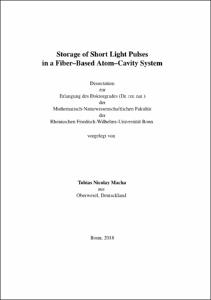Storage of Short Light Pulses in a Fiber-Based Atom-Cavity System

Storage of Short Light Pulses in a Fiber-Based Atom-Cavity System

| dc.contributor.advisor | Meschede, Dieter | |
| dc.contributor.author | Macha, Tobias Nicolay | |
| dc.date.accessioned | 2020-04-26T12:00:28Z | |
| dc.date.available | 2020-04-26T12:00:28Z | |
| dc.date.issued | 16.05.2019 | |
| dc.identifier.uri | https://hdl.handle.net/20.500.11811/7899 | |
| dc.description.abstract | In this work I theoretically investigate and experimentally realize the storage of short light-pulses in a fiber-based atom-cavity system. Our miniaturized optical resonator - with seven times the natural atomic linewidth and a small mode volume - simultaneously ensures a high bandwidth and operation in the strong-coupling regime. In particular, it enables the storage of light pulses with on average one photon and a temporal extent of less than 10 ns, which is more than a factor of two shorter than the atomic excited state lifetime of rubidium. We obtain a storage efficiency of 8 %, consistent with both cavity losses and the employed level scheme. In order to improve the coupling and number of measurements for which a single atom can be recycled, we use dipole-trap assisted, degenerate Raman sideband cooling and a further development of our carrier-free Raman sideband cooling scheme, which permits a three-dimensional ground state population of 70 %. The new techniques increase the measurement repetition rate by two orders of magnitude to ~ 2 kHz. Moreover, for the first time we achieve a Zeeman state preparation fidelity above 95 % in our experiment. On this basis, I present the deterministic generation of single photons in the near-adiabatic limit. By shaping the control laser pulse, we do not only show that we can control the temporal waveform of retrieved photons, but also reach a faster extraction from the cavity-coupled atom than possible in free-space. The quantum nature of the retrieved light is verified by measuring a second-order correlation function, which yields the expected antibunching. Moreover, the generation of photons in the cavity mode with an efficiency exceeding 66 % is used as a fast hyperfine-state detection method, since our traditional, non-destructive state detection via a probe laser is no longer applicable in a Raman configuration due to the absence of a cycling transition. In order to realize Raman coupling between the two hyperfine ground states, we develop a scheme for shifting the cavity resonance frequency between two hyperfine transitions. During the scan, we are furthermore able to determine the atom-cavity coupling strength via the vacuum Rabi splitting in each individual measurement - a useful tool for post-selection of acquired data sets. By employing a numerical simulation based on a full quantum-mechanical master equation, I find the strategy to store a coherent laser pulse with the maximum possible efficiency for a given system. Although the cavity input field is treated classically, our simulation model is able to calculate efficiencies for a pure single-photon Fock-state input. Moreover, numerical optimal control methods enable us to find control pulses with storage efficiencies slightly above those achieved for temporally-scaled adiabatic control pulses. For our specific system, we finally demonstrate the non-adiabatic storage of a short, coherent light pulse. The ability to interact with pulses of high bandwidths encourages quantum hybrid experiments with quantum dots as single-photon sources. In this context, the stabilization of their emission frequency to an atomic transition is required. In collaboration with the IFW Dresden, I present a technique to counteract long-term frequency drifts by applying rate-based feedback to a strain-tunable quantum dot, which results in frequency deviations smaller than 1.5 % of its emission linewidth. By simultaneously stabilizing the emission frequency of two quantum dots in separate cryostats, we enhance their two-photon interference visibility in a Hong-Ou-Mandel measurement from 31 % to 41 %, which corresponds to the maximum reachable visibility for the given emitters. Frequency-stable, efficient photon sources together with atom-cavity based quantum memories may facilitate the realization of quantum networks. | en |
| dc.language.iso | eng | |
| dc.rights | In Copyright | |
| dc.rights.uri | http://rightsstatements.org/vocab/InC/1.0/ | |
| dc.subject | Quantennetzwerk | |
| dc.subject | Quantenspeicher | |
| dc.subject | kalte Atome | |
| dc.subject | CQED | |
| dc.subject | Resonator | |
| dc.subject | Quantenpunkt | |
| dc.subject | Quantum network | |
| dc.subject | quantum memory | |
| dc.subject | cold atoms | |
| dc.subject | quantum dot | |
| dc.subject.ddc | 530 Physik | |
| dc.title | Storage of Short Light Pulses in a Fiber-Based Atom-Cavity System | |
| dc.type | Dissertation oder Habilitation | |
| dc.publisher.name | Universitäts- und Landesbibliothek Bonn | |
| dc.publisher.location | Bonn | |
| dc.rights.accessRights | openAccess | |
| dc.identifier.urn | https://nbn-resolving.org/urn:nbn:de:hbz:5n-54086 | |
| ulbbn.pubtype | Erstveröffentlichung | |
| ulbbnediss.affiliation.name | Rheinische Friedrich-Wilhelms-Universität Bonn | |
| ulbbnediss.affiliation.location | Bonn | |
| ulbbnediss.thesis.level | Dissertation | |
| ulbbnediss.dissID | 5408 | |
| ulbbnediss.date.accepted | 07.03.2019 | |
| ulbbnediss.institute | Mathematisch-Naturwissenschaftliche Fakultät : Fachgruppe Physik/Astronomie / Institut für angewandte Physik (IAP) | |
| ulbbnediss.fakultaet | Mathematisch-Naturwissenschaftliche Fakultät | |
| dc.contributor.coReferee | Stellmer, Simon |
Dateien zu dieser Ressource
Das Dokument erscheint in:
-
E-Dissertationen (4378)




